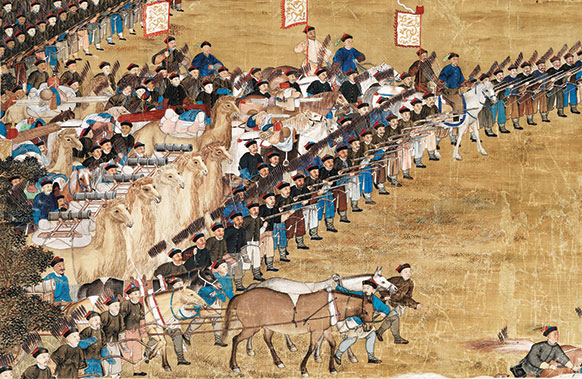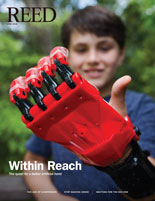
IRIS login | Reed College home Volume 95, No. 2: June 2016
The Age of Gunpowder

Chinese troops defeat Zunghar and Uyghur forces in 1759. Chinese musketeers and artillery camels—yes, camels—played a decisive role in the victory. Painting by a team of Chinese and European artists who collaborated under the direction of Guiseppe Castlglione, aka Lang Shining 읠各寧 (1688-1766).
Why did China’s military technology fall behind the West?
By Miles Bryan ’13
Look up at the night sky over Shanghai during the new year’s celebrations and you might struggle to see any stars—they’re completely blotted out by the radiant flares of fireworks by the thousand. The festivities can get so intense that Shanghai and several other cities last year had to ban the pyrotechnics within city limits.

The Gunpowder Age: China, Military Innovation, and the Rise of the West in World History, by Tonio Andrade ’92
Princeton University Press, 2016
China is famous for being the birthplace of fireworks—and the gunpowder that makes them go bang—but is less well known for the invention of guns. In fact, the Chinese were experimenting with gunpowder’s deadly potential as early as the 10th century; Europe, on the other hand, didn’t adopt gunpowder weapons until the 1300s. But around 1750, Europe raced ahead, in a phenomenon scholars call the Great Divergence. By the time Britain and China clashed in the first Opium War in 1839, the Chinese were hopelessly outgunned. Which raises the question: why did China, which had such a commanding head start in arms craft, ultimately fall so behind?
That’s the issue Tonio Andrade ’92 seeks to address in his well-researched and sharplywritten new book, The Gunpowder Age: China, Military Innovation, and the Rise of the West in World History. Historians have traditionally blamed China’s military fizzle on an insular imperial culture. China, the thinking goes, was held back by a Confucian philosophy that disdained new ideas. By contrast, the Western tradition of free inquiry fueled the explosion of Europe’s military technology.
In The Gunpowder Age, Andrade shoots this argument full of holes. And he offers a counternarrative with sticking power: military innovation in both China and the West reflected what he calls the “challenge-response dynamic.” It sped up during periods of conflict, and stagnated in peacetime.
Take the first major military conflict between China and Europe: the Sino-Portuguese War of 1521–22. The war really consisted of two battles. The seeds were sown in 1516, when Portuguese ambassadors arrived in the southern Chinese port city of Guangzhou hoping to open formal relations. But rumors spread that the Portuguese were cannibals (with a penchant for children), and when the emperor died unexpectedly, the Portuguese fell out of favor. Some were taken prisoner in Guangzhou; a Portuguese trading fleet, which arrived in 1521, refused to leave without them. The Chinese assembled a larger fleet and attacked. But they were held off by the Portuguese ships’ artillery guns, which seemed astonishingly powerful to the Chinese. Many Portuguese escaped.
They wouldn’t be so lucky the following year. In 1522 a new Portuguese fleet arrived at China’s southern coast, seeking to mend relations. The Chinese weren’t having it: they blocked the Portuguese ships and attacked again—this time with cannons that seemed much more powerful than last year. Far fewer Portuguese lived to tell the tale.
While we can’t be certain Chinese forces had adopted Western-style guns, Andrade reckons that it’s highly likely. The Chinese commander, Wang Hong, is said to have encountered some Chinese who had lived in Portugal and who were familiar with the technology, and convinced them to cast guns for him.
Andrade writes that Wang Hong was a member of the Chinese literati who “grew up quoting Confucius.” But that didn’t stop him from racing to adopt European firearm technology—after his victory over the Portuguese, he successfully lobbied the Chinese emperor to install “Frankish guns” on the Great Wall. Indeed, Andrade shows that time and time again Confucian officials had no qualms adopting Western guns and tactics if they believed they could be effective.

Tonio Andrade ’92
Photo by Kevin Liles
And if China didn’t adopt European ideas, it was often simply because they weren’t useful in a Chinese context. Military historians have made much of how Europe copied Chinese gun technology in the 14th century and, within 150 years, had developed heavy artillery that was capable of reducing castles to rubble. They’ve generally written off Chinese guns as being far more primitive. Andrade admits that Chinese guns remained much lighter into the 16th century. But rather than being a sign of stagnation, he argues that this was practical: the huge earthen walls that lined Chinese cities were much more massive than European castle walls. Artillery didn’t stand a chance on them, so China developed lighter weapons meant to be fired mostly at people.
Andrade supports his thesis with an original survey of the frequency of conflict in the West and China. From about 1300 to 1750, war raged through China and Europe at roughly the same rate. But after that, China settled into what Andrade calls “the great Qing peace,” while European states kept shooting, blasting, invading, and conquering one another with monotonous regularity. By the time of the Opium War of 1839, European military technology had been strengthened by recent decades of existential conflict, whereas China had not faced a major threat for almost a century.
Andrade’s conclusions are born out of interest in putting European and Chinese histories into conversation with each other—something he picked up from the European intellectual history classes of Prof. Malachi Hacohen [history 1989–93]. Andrade has been a professor at Emory University in Atlanta since 2002, where he teaches seminars on subjects like “China and the World” and “European Expansion.” In the spirit of a Reed conference, Andrade says he tries to push his students to think through how different histories impact and play out on each either.
The challenge-response dynamic might suggest that China should have been able to adapt British technology soon after its defeat in the First Opium War. It was not so. Chinese reformers yearned for Europe’s brutally exact mortars and new steamships, but they struggled without precision tools like lathes and shapers—“machines that make machines,” as one contemporary Chinese engineer put it. Andrade attributes Europe’s advantage in part to its tradition of experimental science that was flowering at this time, something that had no counterpart in China. Reformers there were further slowed by the bureaucracy and factionalism of the Qing ancien regime. Nevertheless, the intense warfare of the 1800s pushed the Chinese to speed up military development. Although China suffered a humiliating defeat by Japan in the Sino-Japanese War of 1894, it wasn’t due to a disparity in military technology—Andrade shows that Japan’s young Meiji regime simply outmaneuvered and out-fought the forces of the torpid Qing Dynasty.
China’s failure to quickly catch up to Britain, and its defeat at the hands of Japan’s forces despite their technological parity, suggest factors at play in this story that go beyond Andrade’s challenge-response dynamic. If China’s Confucian culture didn’t keep it from innovating, why didn’t it develop a scientific tradition to match that of Europe? And if it’s frequency of warfare that counts, how can Andrade argue that China’s bureaucracy was to blame for its failure to beat Japan?
Andrade sees these questions, and he welcomes them— “all of the above” is his answer. The Gunpowder Age doesn’t seek to overthrow the monolithic narrative of “Confucianism was the problem” with a new monolith of “challenge-response was the prime mover.” Instead, the book brings insights from all kinds of historical sources—Chinese and European, cultural and military—to shed light on a story that’s as complicated as it is consequential. And like any good Reedie, Andrade is determined to keep following the conversation—no matter how explosive his findings may be.


LATEST COMMENTS
steve-jobs-1976 I knew Steve Jobs when he was on the second floor of Quincy. (Fall...
Utnapishtim - 2 weeks ago
Prof. Mason Drukman [political science 1964–70] This is gold, pure gold. God bless, Prof. Drukman.
puredog - 1 month ago
virginia-davis-1965 Such a good friend & compatriot in the day of Satyricon...
czarchasm - 4 months ago
John Peara Baba 1990 John died of a broken heart from losing his mom and then his...
kodachrome - 7 months ago
Carol Sawyer 1962 Who wrote this obit? I'm writing something about Carol Sawyer...
MsLaurie Pepper - 8 months ago
William W. Wissman MAT 1969 ...and THREE sisters. Sabra, the oldest, Mary, the middle, and...
riclf - 10 months ago